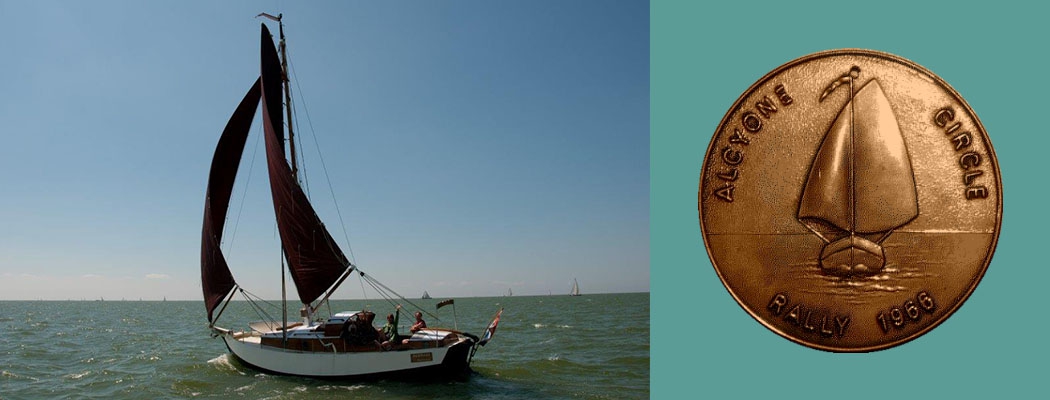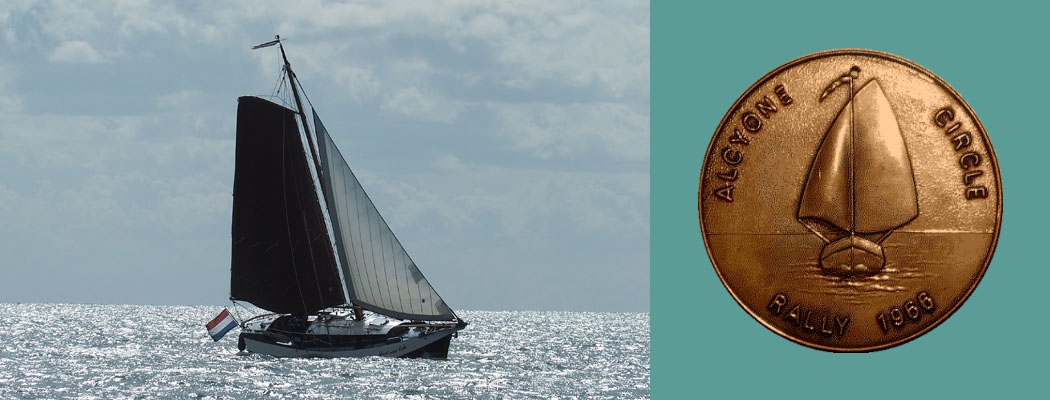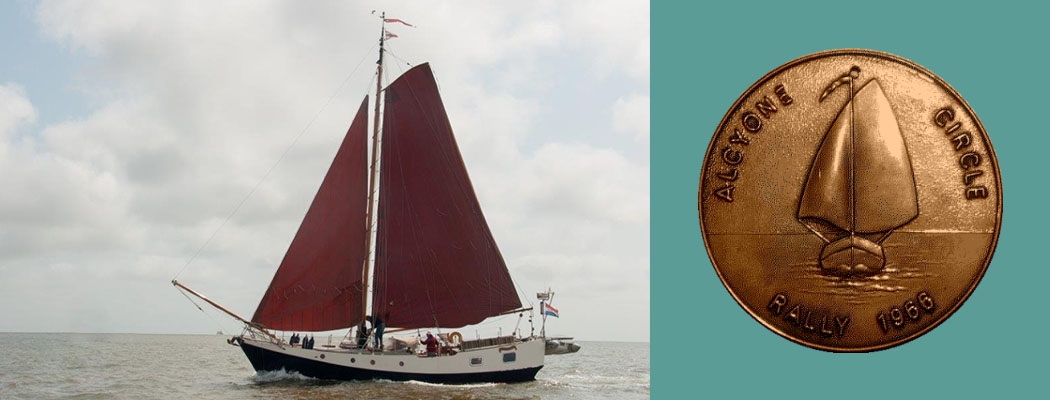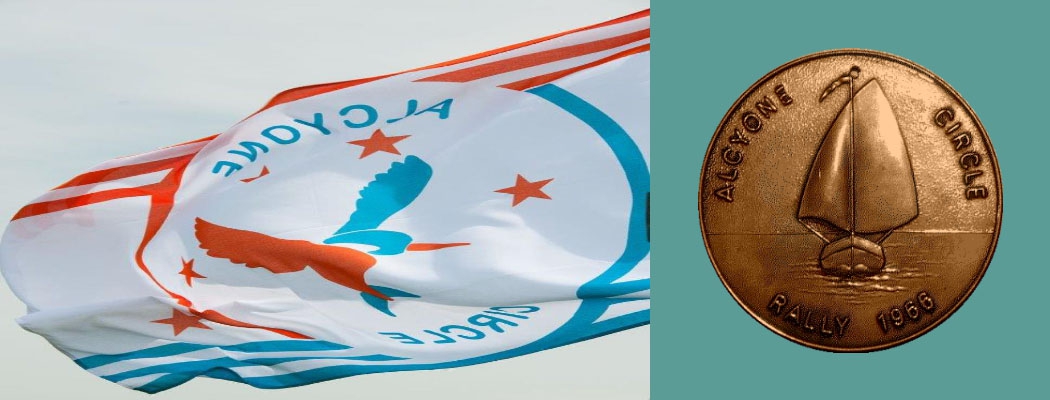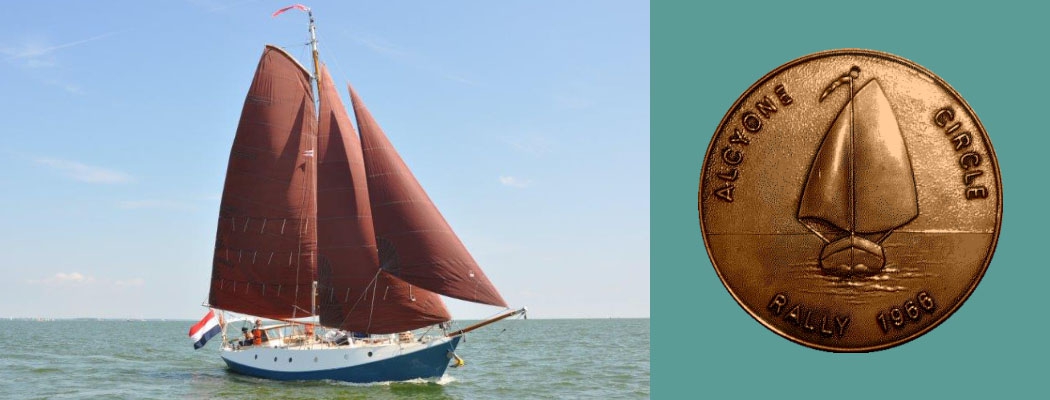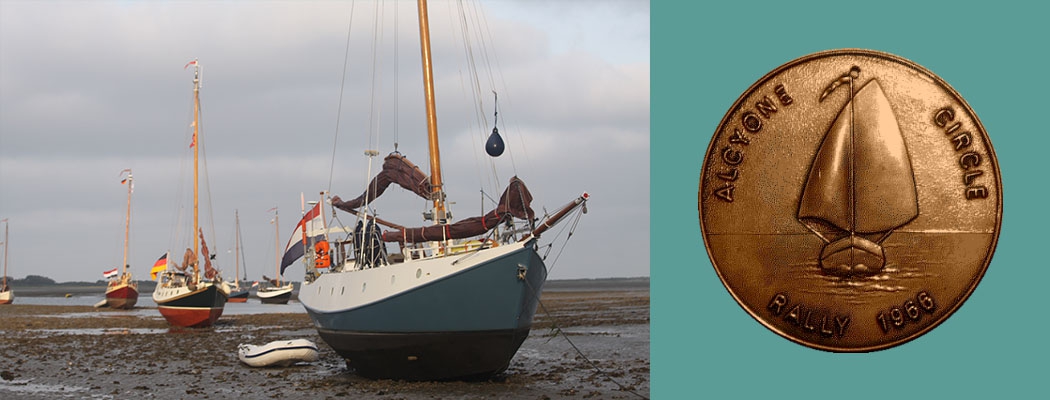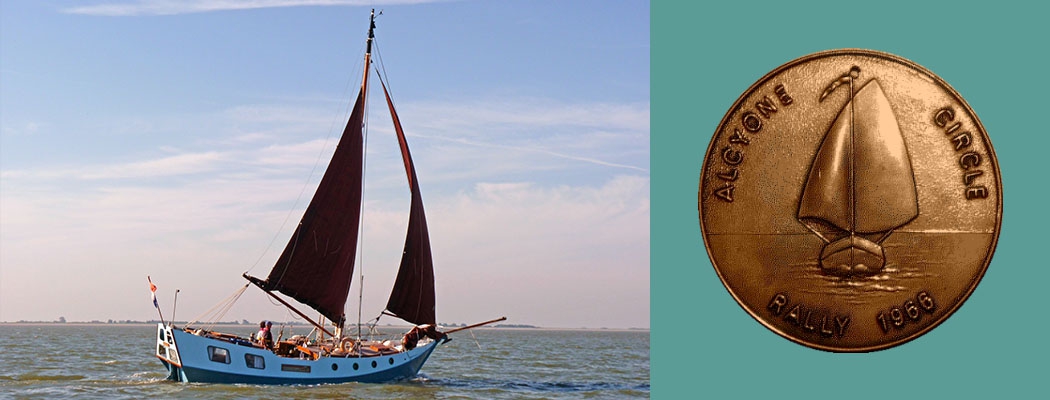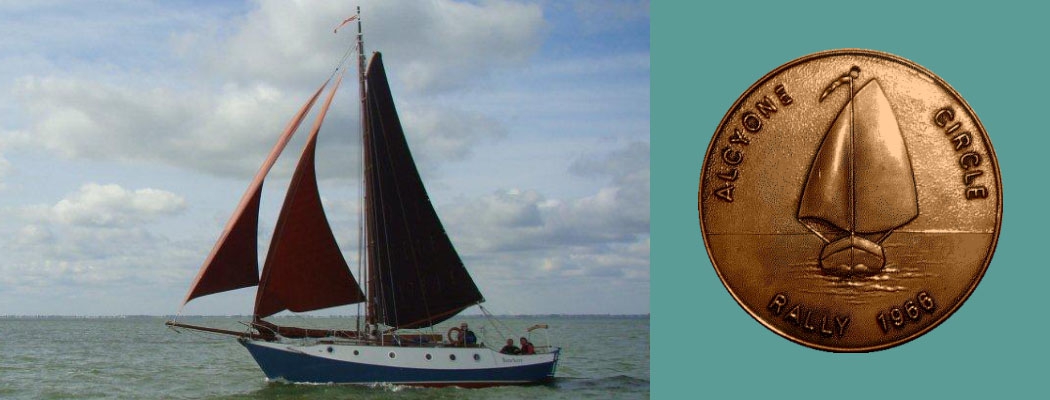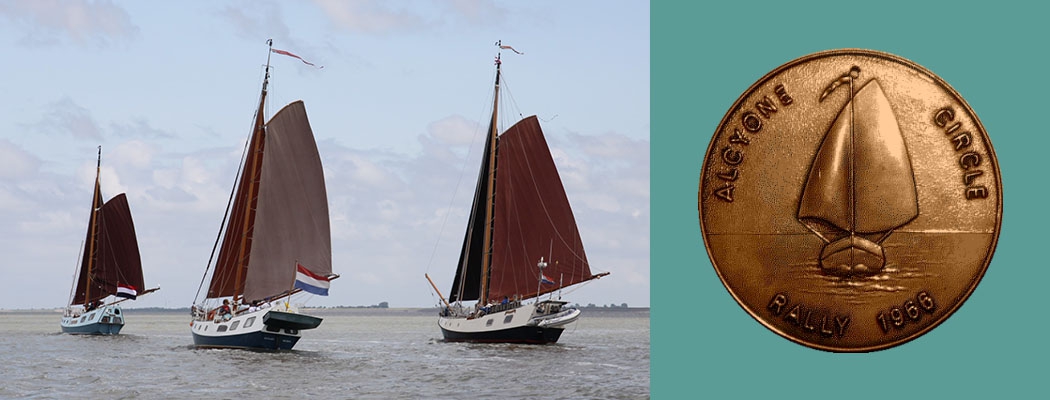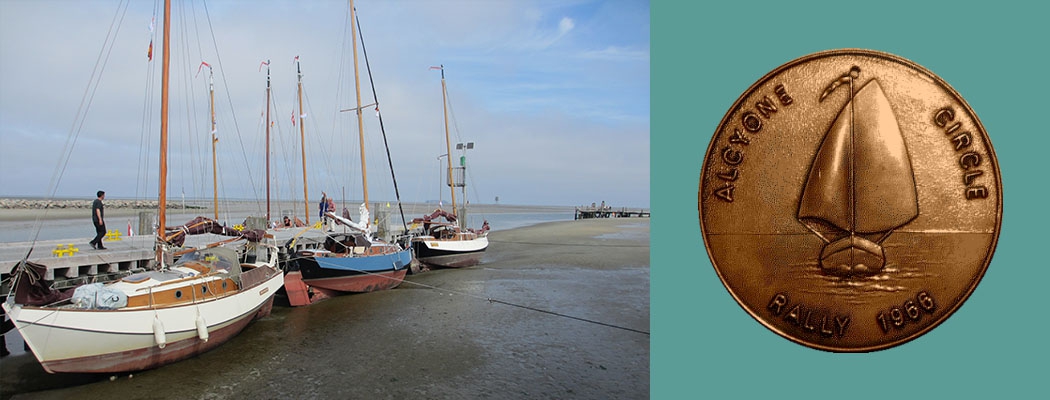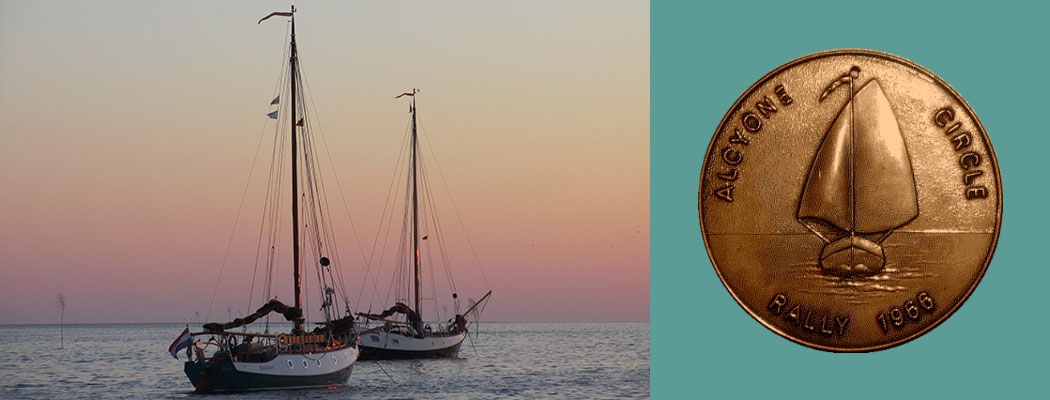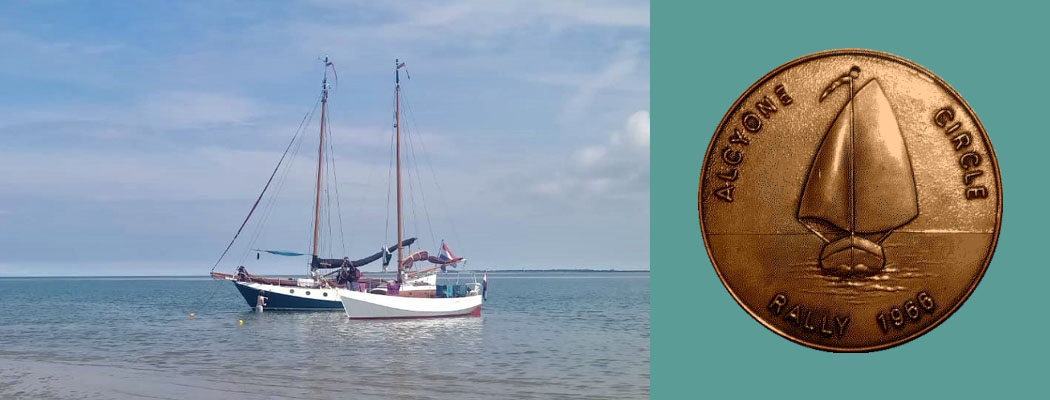 Ships and Owners
Ships and Owners
“Milly Dolly” is ready. The owner, Mr. D.B. rouse has bought the casco and did the rest himself, as before him Mr. Sturm and Mr. Huurman did, the owners of “Dorothy” and “Vrouwezand.”
On the 18th of August 1966, the “Milly Dolly” was launched in the beautiful surroundings of the Salcombe River. Many friends were present a.o. Max Gunning and his wife and Jimmy Cooper, the former owner of “Anna Helena.” Also was present Mr. J.C.M. v. Marle with the “Caecilia.”
We wish the “Milly Dolly” and her industrious owner good luck.
“Polly W” was launched in September 1966 in Langeraar and on the 22nd September she left for a cruise over the Belgian and French canals to Marseilles and so over the mediterranean, on to the Arno. Will and Riet Valentijn with their little son and their brother-in-law, Theo Vastenhout, sailed her to Marseilles where the owner Mr. Bodine and his wife joined them.
“Polly W” is a ship of the “Alcyone I” type but, as usually only Mr. Bodine and his wife will be on board, the interior is altered, so that there is a big cabin and the berths of the owner and his wife are in the fo’c’s’le. The trip from Langeraar to Marina di Pisa was a real Odyssey. A few data follow:
Departure: 22-9-1966
Arrival: 7-11-1966
Underway: 44 days of which the yacht stayed in harbour only 7 days.
Bridges: 489 fixed bridges and 36 movable bridges.
Tunnels: 7
Locks: 253
Aqueducts: 3
Nautical miles made good: ±1000
Hereunder some extracts out of the ship’s log, to give an idea of the difficulties:
“On the 15th October we motored for 10 hours and passed 25 locks. The distance made good was 11,2 nautical miles.
“During the passage from the Rhone to Marina di Pisa the weather was very bad with strong breezes and variable winds.”
Mr. and Mrs. Bodine will be glad their ship is now safe and sound in the Arno. We wish them good luck and much pleasure with the “Polly W”.
Spurwing
Hereunder a note on Spurwing’s journeyings in 1966 from Sir Percy Wyn Harris and some parts of his personal log of Spurwing’s voyage:
“The beginning of 1966 found me as odd-job man on Tim’s farm in New Zealand. It was there I met Mac White, aged 24, who offered to crew Spurwing across the Pacific.
In mid-February we flew into Grenada, at moorings ever since Dave Moore and I had left her six months before at the end of our voyage from Greece via The Gambia.
With Mac doing most of the work, we spent a busy and very happy time slipping Spurwing on the little Yacht Club slip, painting her, and generally fitting her out for her voyage.
On March 31st, we set sail northwards. We had a splendid sail to Carriacou – past the rock with the hole in it called London Bridge and then under the precipices of the towering lump which goes by the splendid name of Kick ‘em Jenny, from the tumultuous seas which it produces when there is anything of a wind. And then in the evening, past the sisters which guard the entrance to Hillsborough Bay on the West side of Carriacou, past Sandy Island where Dave last year got some spear fishing and then on to the uneasy anchorage opposite old Linton Rigg’s little Normaid Tavern. Linton had retired to his country retreat “Tranquility” over at Windward village as he found his hotel guests too troublesome. He had left in charge Finola, a charming Irish girl – an air hostess on long leave from her airline and who had been managing the hotel for three months. John Slominski arrived in his little Yanka, and we had three pleasant days sailing about the Island and while passing between two rocks known as great and little Mushroom Islands foolishly neglected to remember the tidal streams which run strongly at the full of the moon at half ebb and got carried too close to the Great Mushroom and touched a reef with our centre board and rudder. However, Mac got the engine going and we slid into deeper and smooth water – very cross at a careless piece of pilotage which could have had unpleasant results to Spurwing. However, we hooked a large Spanish mackerel a few minutes later, which Finola cooked for supper and on a lovely moonlight night rowed Finola back to the Normaid after a day full of incident.
We sailed northward from Carriacou and passed through the narrow strait between Union and Prune Islands. then over the reef in two fathoms of water to the Tobago Cays. this has become very much of a rendezvous for the Charter Yacht Fleet and there were half a dozen yachts in the anchorage, so we sailed through the islets and on to a bay in the Mayero Island which we had to ourselves.
The following day in a fresh breeze we sailed to Bequia, the most northern of the Grenadines, and dropped our hook just astern of John in his Yanka. We spent four days at Bequia getting a very splendid old Bequian, Mr. Simmonds a sailmaker, to refit our coconut mats and repair our awning. There are a large number of families in the Windward Islands of British stock who have been there for several generations and Mr. Simmonds and his brother-in-law Mr. King are two splendid characters of the European Bequians.
From Bequia we sailed to Cumberland Bay, in the north of St. Vincent and after spending the night there on to Castires, the capital of St. Lucia. From St. Lucia we sailed to Fort de France the capital of Martinique. We had a very pleasant week in this very French Island in company with John in his Yanka, who is spending part of his long leave cruising single-handed to the Virgin Islands, Mac and I spent a long two days adjusting our compasses, as I found that both of them had developed errors of anything up to 15 degrees. We worked out deviation cards for them and the curves are now better than the ones that were made professionally at Gibraltar. John left an hour before us from Martinique and at 2:00 pm on Monday april 25th, we got our anchor in and were in the process of setting sail, when John returned because a leak which had been troubling him had got much worse and he decided he must go up on Mons Grants slipway and get it dealt with. We waved goodbye and set our course from Fort de France for the Northend of Bonaire, 480 miles away.
Behind the Island the wind was fitful and in the gusts fresh and Virginia, the Vane, could not steer very well. The wind was almost aft, and in any lull the vane did not get enough wind to correct in time and we yawed. Twice the main gybed, on each occasion parting the nylon guy. So I decided to steer further to the north and when we were nearly in the longitude of Curacao to gybe and to approach the Island from the north. I did not want to make my landfall on the South American coast to the eastward of Curacao as there are a series of extensive reefs, mostly unmarked, which lie, to the downfall of the unwary, some sixty miles off the coast of Venezuela. The worst of them are the Islas de Aves, sixty miles east of Curacao.
We had the mainsail hoisted rather high on the mast, and the somewhat cumbersome wire parrel had caught under the forward starboard shroud and was threatening to crack the gaff jaws. So Mac had to climb the parrel lines of the main and with the pipe wrench hauled up to him on the signal halliards he cleared it. About 9 pm, when we were well clear of Martinique, the NE Trade steadied at the top of force four and the vane began to steer fairly well.
At 2:00 am on the morning of Tuesday, Mac relieved the watch and I have recorded that the wind was fresh and that there were biggish seas; that both of us felt queasy. In point of fact we felt queasy most of this journey as the movement was fairly violent and neither of us had had enough of it to be used to it.
At 8:00 am the foresheet came adrift and had to be reset. At 9:30 am I took my first shot at the sun but owing to the rolling and the fact I was rusty on the knack, the result did not fill me with any great confidence. At noon, I thought to get a suns meridian for latitude only to discover that the northward declination of the sun and our own latitude were almost identical, so that for the passage the sun was not going to be much help for anything except position lines near the longitude. I tried that evening to get a star shot for latitude to cross with the satisfactory sun shot I had got in the afternoon, but the roll of the ship and scud which obscured the star made it impossible.
At 3:00 pm the starboard after shroud parted. This was not of great moment as these shrouds are auxiliary to the original rig and were the only piece of standing or indeed running rigging I had not renewed at Grenada. We repaired the break with a short piece of spare wire and the indispensable bull dog clips. During Wednesday the wind continued fresh with biggish seas and I got two good shots of the sun which gave me a very fair idea of my longitude, but owing to the roll I failed at twilight to get a satisfactory sight of the moon.
On Thursday, I have recorded that both of us were very queasy and that the ship’s movement was at times violent. I worked two good sights of the sun in the forenoon and at 11:45 am.
We gybed ship and sailed on true course 2190 True to pick up the South East Point of Curacao, which I put at about 100 miles off.
It was satisfactory during the afternoon to bring the direction finder on deck – it won’t work below in a steel hull – and after a bit of fiddling in the protection of the companionway awning to hear a bleep bleep which our primitive morse gradually recognized as .–. .— –. P.J.G. the radio beacon on the airfield at curacao. As it was 10¾ on our starboard hand we were on course. As night fell that evening I decided that we would have to maintain careful watch and as both of us were very tired, I decided to heave too on the port tack, which we did by hauling the staysail aweather, giving her the whole of the centre board, and fixing the helm alec. The movement became very much quieter and we jilled along roughly on our course at about a knot. It gave us, if not a quiet night, at least some rest. At dawn, we got under way again, and with the radio signal steadily strengthening we continued on our course.
At 2:00 pm with the wind abeam Mac spotted land ahead, low about eight miles off. It was clear we had come a little too far down wind, so we came close hauled to weather the SE point of the Island – Punt Kanon. We had two reefs down and to help I put on the engine. As we approached the Island it was clear that we were not going to weather Punt Kanon by the minimum two miles that the Admiralty Pilot lays down as a minimum to offset the west going current that drives on to the point, and the warning that the seaward coast of the island should not be too closely approached was borne in on us as broken water with sheets of spray thrown high into the air began to appear a mile over our bow. We were in deep water and a good four miles from the coast, but the great rollers hitting the inhospitable east coast recoil giving a very confused sea for some miles to windward. So we tacked to get an offing and to get to weather of the point. When we tacked again at about five pm, it was clear that we would not weather the point before dark, and in spite of a moon, I felt that discretion was the better part, so we ran north along the coast about four miles our some mile or so clear of the broken water. Even so, the seas were big, steep and often confused. With the wind freshening to force 6 to 7 we handed the main and by nightfall were about five miles short of the Noordpunt so keeping our offening we ran on under the double reefed main until Noordpunt light was on our quarter. It was now time to change course to round the point and get in the quiet lee of the Island. I decided that it would be safer to stay the ship rather than gybe and Mac was actually down below priming the engine when, whether from inattention on my part, or a rogue wave, we suddenly yawed and did an all standing gybe. There was a crash and the main boom which has served Spurwing so will from the Baltic to the Carribbean was in three pieces with the mainsail draped unhappily round the rigging. We started the engine to give us some control, and Mac got the mainsail down and the wreck of the boom secured – no ordinary feat -and we set the staysail. Fifteen minutes later we were round Noordpunt and in calm water. A day later we beat up to Willemstad, the very Dutch and friendly town of Curacao. Fred Rusch, a resident businessman, took us under his wing, and among many kindnesses procured us a new main boom to replace the one smashed on our rough passage round Noordpunt.
Then 800 miles westwards with Venezuela and Columbia to port to Cristobal, at the entrance to the Panama Canal. Here we lay at the Yacht Club jetty for six weeks, pulling out the engine to repair the gear box which had been making ominous sounds of dissolution and also to reweld the rudder assembly, which had been badly strained. Our stay was enlivened by a lively Panamanian riot when the students burnt out the GPO and also several other government buildings. But we enjoyed most our fellowship with several other small yachts pausing on their voyages – notably two couples who were completing circumnavigations, Malcolm and Muff in “Seawind” and Hein and Sigge in their tiny “Thlaloca”.
At long last with Malcolm and Muff coming as line handlers and under the pilotage of Capt. Mixon of the Canal Authority – pilotage is compulsory through the canal – we set early on June 28th to do the transit to the Pacific. As we climbed through the three great Gatum locks into Gatunlake, I was more than grateful for Capt. Mixon’s quiet advice and even more his help, for the millions of gallons of water pouring through the bottom gratings of the locks as they filled up caused eddies which were considerably more violent than I have met in any European canal lock. We were centre locking, two at bow and two at the stern, and we were very glad of Malcolm’s and Muff’s stalwart tending of the lines. We arrived in Balboa, at the Pacific end of the Canal in thick wet darkness, and picked up our assigned mooring buoy at the tail end of a roaring thunderstorm and in a swinging ebb tide.
We lay in the anchorage while we went provisioning in Panama City – three miles away. A week later, after a cheerful evening with Malcolm and Muff in Panama City – finishing up in the casino of the Panama Hilton, we got under way at first light down to the open sea, with Malcolm and Muff, who were leaving the next day on their last touch leg to San Diego, California – blowing adieu on Seawind’s foghorn.
And so we chugged on a glassy sea forty miles down the Gulf of Panama to the charming Islas Perlas, where we lay two days in completely deserted anchorages. We got out our big game rod, and while we caught nothing enormous, we got into some twenty five pound dorade which gave us exciting fights as we circled Spurwing to keep the line from fouling the rigging. They were excellent eating.
Then southwest towards Cape Mala at the entrance to the Gulf, where when we were abreast and five miles off we took our departure for the Galapagos Islands, 800 miles away.
Gradually the friendly flash of the light and the steady procession of lighted ships bound to and from the canal disappeared over the horizon and before first light we were well out of the shipping lanes and on our own.
For the first two days with the light airs of the doldrums and the occasional rain squall we kept our old one lung diesel thumping away to make as much southing as possible. Sun sights in the sticky overcast were not easy, but we got enough breaks in the cloud to keep tabs on our position, and I was most pleased with the new sextant – my old one dating back to 1880 having become more and more difficult to read.
On July 9th, two days out from Cape Mala, I fixed our position as some sixty miles due east of the uninhabited, unlit little horror – Malpalo Island. As the wind had backed to the south east and had freshened to force four we tacked ship and creamed along closehauled on the port tack pointing direct towards our destination. Twenty four hours later the wind had veered once more to the southwest, so once again we tacked and found us steadily closing the South American coast near Esmeralda, in Ecuador. So back on the other tack for two days and finally when the wind backed again we were able to point the Galapagos once more and for three days had splendid runs. But as we approached the Islands we met the Humboldt current which sweeps round them at this time of the year in a north westerly direction at a rate of 45 miles a day, so although in twenty four hours between noons we did 170 miles, we were being carried too far to the west and had to fight the current, making good the next day towards the Galapagos only 19 miles – one of Spurwing’s real lows. But as the more northernly islands broke up the current we made better distances and towards evening we made our land fall and picked up the western end of Sann Christobal – our destination. After a damp and windy night beating up the coast of the Island, we spotted lights which I thought to be Bahia Wreck – the only inhabited spot on the island, but they turned far too rapidly for my comfort into a giant Japanese fishing ship bearing down on us at speed, so we turned and scuttled off into the dark. The current had carried further off shore than I anticipated, and there was no sight of the Island at dawn, but after half an hour beating, we picked it up and by three pm in the afternoon of July 20th – 18 days out of Panama – we anchored off the ruined quay of Wreck Bay. (Lat. 0º 53’ S Lon. 89º 36’ W.)
We spent an enchanted month in the Galapagos, much of it in desert bays under the lava flows, our companions the sea-lions, the penguins, cormorants and sea iguanas. We even had a whale as a brief and somewhat alarming neighbour in our last anchorage. But it was the sea lions who stole the show. When we put Spurwing ashore on the tide to renew our antifouling, the sea lions just lay on the beach and watched us. We could wander among them and even nudge a baby to wake it up and make it pose for a photograph. Except for one jealous old bull who came flopping at us hurling abuse, our relations were of the friendliest, even to one flighty young lady who insisted on bathing with us and adored her face being splashed. The pelicans and the frigate birds mobbed us when we fished, even sat on the gallows, tried to take our baited hooks and fought us for the fish we caught. Mac, armed with plimsolls and an ugly looking knife, hunted the wild goats across Islas san Salvador and finally, with the skipper acting as beater, ran one down. We carried the carcass in triumph back to the ship – and you have not really dined if you have never tasted our “Chevre en surprise a la Galapagos.”
And so on August 14th, being in all respects ready for sea, we cleared a badly fouled anchor from the lava rocks and the bottom and with some difficulty in the fresh breeze blowing, and the numerous rocky heads encumbering our tiny lagoon made for the open sea. Having cleared the island we set our course WXS towards the Marquesas, 2970 miles by the Traverse Table. By dawn the following morning , the volcano was below the horizon.
We made disappointing daily runs for the first few days – our worst was 89 miles which included the 20 miles favourable South Equatorial current. But then the South East Trades strengthened and with, for the most part, full mainsail firmly guyed and the staysail boomed Virginia our self-steering wind vane began to take us westward deeper into the deserted ocean. We did not expect to see another vessel and we did not, and as the chances of collision are remote, in order to save our batteries we ploughed on unlit. the vane behaved well so we could get good nights sleep – only going on deck from time to time to check the course and the gear.
We were both kept fairly busy – Mac cooking, washing up and doing nearly all the work of the ship – myself navigating, doing some of the maintenance and repairs. The wind never blew above force 7 and usually about force 4. Our best run between noonday sights was 162 miles.
Here is the log entry for more a interesting day:
Saturday August 27th. (zone time ±8) a day of repairs. Wind fresh force 5 to 6, steep seas. Cloudy. We replaced the broken bottle screw on the forestay with chain and shackles. (This had happened the previous evening and we had effected a temporary repair using the anchor chain). The sliphook on the windward runner had distorted. Set up mast lowering stay as temporary runner and replaced the sliphook with a four inch shackle. Then turned both the foresheet and mainsheet end for end as they are showing signs of wear.
Guyed main to starboard, one reef down. Big breaking seas by nightfall, wind squally and occasionally touching 7. Making over 6 knots. Two poorish sights due to roll gave latitude 6º 40’ South Longitude West. Days run 136 miles. Total run 1658 miles.”
By September 4th, when we had something over two hundred miles to go and I was working the noon sight, Mac let out a yell that a whale had surfaced twenty five yards away on our port quarter and had blown. I scrambled on deck, but to our relief he did not appear again. That afternoon I saw another large creature close to under the surface, which I think was a giant ray, but could not be certain.
The following day we were getting close to the more westerly of the Marquesas group, and our noonday sight showed that we would pass about 35 miles to the north of Fatu Huka, so I did not expect to see it; but at 3:30 pm (ships time) Mac spotted at a great distance its rocky peak broad on our port beam which confirmed our position. During the night we passed to the sough of Ua Huka, which we gave a fair offing as like the rest of the group it is unlit and the shortly after midday sailed between the two Sentinal Islets at the entrance of Taihaie Bay under the steep mountains/Nuku Hiva, and dropped our hook twenty three days out of Fernandina – a good passage averaging 128 miles a day. Speed just over 5 knots.
We lay at Nuka Hiva 7 days meeting four American yachts there, including the lovely 130 ft. Square Rigger the Barque Carthaginian. We then sailed the 700 miles to Tahiti. The first two days were squally with big seas which filled the cockpit twice. Poor Mac had to get all sail off her five times in the first day as the forbidding squalls swept down on us. The weather improved for the rather tricky navigation through the Tuamotu Atolls. We hove to when among the Atolls for some hours during the night and jilled gently north, with the staysail aback and the main started, rather than traverse the channel between Rangiroa Atoll and Arutua Atoll on a moonless night, and so on the evening of the eighth day the astonishing peaks of Tahiti came over the horizon, and the light of Point venus winked at us as we lay hove to waiting for the first light to take through the pass in the reef into Papeete harbour.
We are hoping to leave Tahiti on October 3rd for Rarotonga, lay there for three weeks and then take the long haul to New Zealand. This may be a slog if as we get further south we run into the New Zealand Southerlies or Westerlies.
We heard Sir Percy arrived safely in New Zealand and we hope to publish the tale of his voyage to there in our next newsletter.
Carapace
In the “Boston Traveler” of July 5, 1966:
“Living on the “Carapace” Delightfully Cool”
Boston architect Eduard Bullerjahn has been a boat enthusiast all his live. His wife, Juliana, doesn’t like what she calls “the yachty business.”
But, like Jack Spratt and his wife, between them they’ve licked the matter clean. Now, all summer, they live aboard a 34 foot sailboat, “Carapace”, moored at Eastern Yacht Club in Marblehead.
“I thought I’d like living on a boat if it seemed like a house,” said Mrs. bullerjahn who had done some boating and sailing as a young girl. (she’s the former Juliana Sweetser of Brookline.)
“She told me she’d go sailing if she could go “downstairs to the kitchen” and not “below to the galley,”” Bullerjahn added. A native of Michigan, he grew up sailing the Great Lakes.
As it turned out, Juliana was the one who actually found the “Carapace” which they bought six years ago.
The family (which includes sons John 13, George 10, and two older boys – William who is in the Navy in vietnam and Stephen who’s college age and working on Cape Cod) had decided on a motor cruiser, a sort of mother boat for a small sailboat.
They planned to make major trips with the cruiser and use the sailboat for shorter excursions wherever they cruised.
Then Mrs. Bullerjahn heard about a dutch sailboat, a grundeljacht, built in the boatyard of J.W. Valentijn & Sons, Langeraar, Holland, in 1954 for an American couple. The vessel had been used to cruise in European waters for two years and then was taken to the Bahamas.
To sailor Bullerjahn, who has dutch ancestry on his mother’s side, it seemed ideal. So they bought it. It has turned out to be practical and economical.
“Comfort and stability are the best things about it,” he told us. “Speed is not the thing although the boat is rated so highly we supposedly could race it while serving tea down below. Our fuel bill last year for the engine (an air-cooled diesel) and electricity for water pressure and lights was $12.45” he added.
“The galley is the only kitchen where I really like to cook,” Mrs. Bullerjahn confided. “I’m with everybody and there are no vast areas to clean up.”
Favorite foods are broilers, steaks and dishes easy to prepare on the two-burner bottled gas range with its combination broiler-oven. Frozen foods are out since the Bullerjahns discarded the electric refrigerator in favor of an ice box which uses 100 pounds of ice a week, usually delivered in 50 pound loads twice a week.
There’s running water, hot and cold, for the galley sink and “head” or bathroom between the main cabin (sitting room) and the two sleeping cabins. To shower, one merely closes the doors and turns on a hand spray. Bath over? Pull up a plug in the floor and the water drains out of the room.
How else does the boat look and feel like a house as Juliana wanted?
Well, there’s a fireplace in the small main cabin. In keeping with the Dutch atmosphere, it’s early 19th century faience – a blue glazed tile – with a copper stovepipe. The Bullerjahns found it in a local antique shop. Designed for a boat, the unit burns charcoal. “We’ve never had a hot night aboard,” said Bullerjahn. “The floors are always cold – you need sneakers.” He explained that the boat is built of wrought iron and the cement flooring is chilled by the icy waters.
“The galley floor has terrazzo right on the cast-iron ballast. But we added teak parquet to the living room floor,” he said. The homey atmosphere is also found in the small paintings and etchings on the walls and doors (the Bullerjahns are art collectors) and chunky colored-glass portholes. “Dutch boats usually have stained glass,” Eduard told us. Juliana found the multi-colored disks in a Back Bay shop one Christmas. She found they fit the portholes perfectly. The closet and drawer space is adequate for the four Bullerjahns, according to the lady of the boat. John and George have the forward cabin with v-shaped berths and storage beneath. Ed and Juliana’s cabin, with upper and lower berths to starboard has a closet. And then there are the bookshelves no home is without. The Bullerjahns have tucked in their favorite volumes – including Lloyd’s Register of Yachts. “The nicest thing about boating,” said Mrs. Bullerjahn, “is that you meet old friends you haven’t seen in years. When a boat from another harbor come sin looking for a mooring, you might look up its name in Lloyd’s and discover an old friend from prep school or college.” How did “Carapace” get its name? It was on a list Ed Bullerjahn made up as a boy. He longed for a boat and was delighted with ta line from robert Louis Stevenson about sailboats seeming to carry their houses on their backs like tortoises. He looked in the encyclopedia and found a tortoise lives in a carapace. Now, so do the Bullerjahns.
“When the rudder divides the stern, you need a name that separates well,” he added. “Cara” and “pace” in Italian means “blessed peace.”
Meeting 1966
Motto: “Don’t worry Gunning, we are still running.”
The meeting being held on the 30th and 31st of July 1966 was, notwithstanding the weather, quite a success. The first yacht arrived a week early in Delta-Marina, Kortgene, the last one arrived on Saturday morning and each arriving yacht increased the fun.
The fresh South Westerly wind did not exactly help the yachts coming from Holland, and the engines had to be used for quite a long time. The “Margaretha” of Mr. Bolte managed to sail in one day against wind and tide from the Braassemer Meer to Kortgene.
the following ships were present:
Alcyone I type
Alcyone I
Banckert
Caecilia
Helena Anna
Alcyone II type
Blue Griffin
Dorothy
Dotterblume
Oogwaai
Cormorant type
Cormorant
Dorine
Eenhoorn
Frinke
Margaretha
Marmara
I always take a special pleasure in looking at our ships to see how different owners, notwithstanding the uniformity of the ships, have been able to impress their own mark on their own boat. In my opinion, the following should be mentioned:
Caecilia a vane self steering gear
Blue Griffin special bow sprit to reduce weather helm and greet many gadgets including an electronic automatic self steering device.
Marmara arranged for single-handed sailing. Mainsail can be raised and lowered from the cockpit.
Dotterblume by far the best maintained ship of the fleet
Alcyone I 18 years old, mother ancestor of us all, and still going strong.
On Friday morning we all came together for a drink and a talk in the restaurant of Delta-Marina. Old friends met again and new friends were made in an easy and friendly atmosphere. During the reunion it became clear that the participants could be split into 3 groups:
1. grown-ups
2. youngsters in their early twenties
3. children of about ten.
All these have thoroughly enjoyed themselves. It might be a good thing when organizing the reunion of 1968 to bear this matter in mind, for instance during the reunion it was obvious that some arrangement for baby-sitters should be provided.
On Saturday morning the captains, “palaver” took place. In view of the fact that it was blowing hard and that many yachts were short handed as regards experienced crews and that many small children were on board, it was decided not to sail to Zierikzee but to go there by car or bus, by way of the bridge over the Oosterschelde. In the afternoon, many ships went for a sail. They left harbour at short intervals; a rather spectacular sight which drew the attention of all by-standers who voiced their admiration in no uncertain terms. The going was hard.
Another highlight of the meeting was the cocktail-party and dinner in Hotel Concordia in Zierikzee. A separate dining room was reserved. The 50 guests were seated at three long tables. The seating was arranged as far as possible in accordance with the three age groups mentioned above.
The chairman in his speech welcomed all present with special mention of our guests Mr. and Mrs. Gunning, the brothers Valentijn and also owners and crews of British and German yachts who had undertaken such long journeys in order to be present at the reunion. Many speeches followed. Captain Sanders and his crew gave us all a great surprise by performing at the piano various songs specially written for this reunion. the long and spontaneous applause which followed was certainly well earned. Jhr. Sandberg will kindly see to it, that all present will receive a copy of these songs.
All owners were pleasantly surprised by the promise of Will valentijn that the yard will present a commemorative medal.
Mr. Dijkgraaf kindly saw to it that arrangements were made to take participants without private transport with special bus to Zierikzee. Many thanks are due especially in view of the fact that I am under the impression that expenses were not covered by revenues.
On Sunday morning, an owners meeting was held. Two new members were coopted to the working committee viz. Mr. Sturm (Dorothy) and Mr. Ahrend (Dorine). It was decided to hold the next meeting in 1968. A trip through the Biesbosch and perhaps a dinner in Loevestein Castle are planned. Now that the Biesbosch cannot escape the consequences of the Delta plan it is perhaps a special attraction to make a final trip through various narrow, less well known but beautiful channels. Sunday about 12:00 the fleet left port and sailed west to a rendezvous. All ships moored alongside each other. This trot was moored by 4 anchors so that notwithstanding the strong wind no dragging took place. Everybody moved free from ship to ship. sherry flowed freely and everybody was in high spirits. Highest marks without doubt should be given to Capt. Sanders who arranged the show on “Blue Griffin” to the joy of grown ups and children alike.
I never saw children so fascinated as during this show. they were completely captivated.
At 16:00 the reunion was dismissed and everybody went his way. The wind was very much weaker and the fleet sailed with the genoa’s boomed out dead before the wind at some one to two knots to Delta Marina, where many took their supper in the “fo’c’s’le.”
We found Delta Marina to be well organized and well run with proper facilities. Many mothers with small children found the launderette not only a much appreciated facility but also a welcome place for gossip.
All praise to mr. Casimir and his assistants!
In conclusion, I am firmly convinced that the reunion 1966 was a great success from every point of view.
Special thanks are due to: Mr. and Mrs. Gunning for coming from England to be present at our reunion, Brothers Valentijn for being present and for the commemorative medals, Captain Sanders and his crew for his shows during the dinner and at the sherry party which added so much to the merry making. Mr. Dijkgraaf for organizing transport by bus. British and German participants for the long trip they have undertaken to be present. All participants for coming and playing their part in the general success of the reunion. It is a pity that not more owners of Gunning ships were able to join us. “Les absents avaient tort.”
Photo
We promised Max Gunning during the meeting an album with photos of all the yachts of the “Alcyone circle.” So far only a few photos have arrived. Yacht owners who did not yet do so, are kindly requested to send a photo (size ±13×18 cm (5×7”) is suggested) to Mr. B.v.d. Ploeg, Jacob Mulderweg, 22 Den Haag, Holland.
Contribution
At last. A new year has begun also for our circle. Yacht owners who did not yet do so are kindly requested to pay a contribution over 1967 of £1.- or Hfl. 10,- to the account of the Alcyone Circle with mssrs. C. Lind & Zoon, Herengracht 479, amsterdam (Postgiro 47017).
Regatta Cormorants
There is a possibility that in the end of this summer there will be held in Holland on the “Westeinder” an official regatta for Cormorants. it is very important that as many cormorants as possible will be present. So we kindly request owners of these yachts to do their best to attend the regatta. Particulars will be given as soon as possible.
Correspondence
Kindly forward correspondence to:
B. van der Ploeg
Jacob Mulderweg 22
Den Haag 1 A.
Tel. 070-55.63.82

